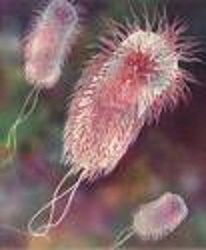Team:Mexico-UNAM-CINVESTAV/Project/Cold shock response
From 2010.igem.org
m |
|||
| Line 23: | Line 23: | ||
| - | + | [[Image:Csr2.jpg|thumb|center|550px|left|Cold shock response | Taken from Taken from Horn G, Hofweber R, Kremer W, Kalbitzer HR (2007) Structure and function of bacterial cold shock proteins. Cell Mol Life Sci 64: 1457–1470]]Also the cell has many other proteins that are involved in the protein, DNA or RNA stabilization at low temperatures: RecA, which is involved in recombination and induction of the cold shock response; H-NS, a nucleotide-associated DNA-binding protein, which is required for optimal growth at low temperature; GyrA, the subunit of the topoisomerase DNA gyrase, which helps to uncoil the double helix of the DNA; NusA, which is involved in termination of transcription; PNP, which is an exoribonuclease; and Hsc66, a Hsp70 homologue to cold (Thieringer, et al; 1998) (Yamanaka; 1999). | |
| - | [[Image: | + | |
Evidence indicates that the Csip's express only when the cold shock occurs. Their presence decreases as the growth phase gets closer and next is minimal again when the growth phase begins. In the case of non-Csip's, the expression is normal at physiological temperature. As soon as temperature downshifts the expression decreases and stays low in the acclimation phase. When the growth phase starts the non-Csip's increase their expression but stay in a low rate (Horn ''et al.''; 2007). | Evidence indicates that the Csip's express only when the cold shock occurs. Their presence decreases as the growth phase gets closer and next is minimal again when the growth phase begins. In the case of non-Csip's, the expression is normal at physiological temperature. As soon as temperature downshifts the expression decreases and stays low in the acclimation phase. When the growth phase starts the non-Csip's increase their expression but stay in a low rate (Horn ''et al.''; 2007). | ||
Revision as of 05:52, 27 October 2010
All organisms have different mechanisms in order to adapt to variable temperatures. Escherichia coli shows a mechanism denominated Cold Shock Response, which is important since at low temperatures the production of cytoplasmic proteins becomes blocked and E. coli cannot growth (Yamanaka; 1999).
The CSR consists in the expression of a specific set of proteins called cold shock proteins (Csp’s) to overcome this translational block. The cold shock protein A (cspA), which is the one we will use because is the one most studied protein of the family, has tree control processes involved with the system. The first control point is the auto regulation system Cold Box implicated with the cold shock protein. The second one is the 5’UTR mRNA region capability to become unstable at 37ºC. And the last one is at traductional level with the two ribosomes binding sites and an anti-DB sequence in the ribosome which allow to synthesize proteins at 15ºC or a little less (Yamanaka; 1999). But, how the expression of csp’s genes is able while the synthesis of most cytoplasm proteins is blocked? First, the cspA mRNA transcription is constitutive both at 37°C and 15°C, but the cold shock proteins expression is only present at low temperatures. This means that the mRNA is synthesized but the expression of proteins depends on the cspA mRNA sequence factors:
Promoter- cold box - 5’UTR - SD -DB
Promoter: The promoter consists of 50 bases. This promoter is active at both 37ºC and 15ºC but is more efficient at 15ºC than other promoters because it has an important UP element AT-rich that is report to be recognized by the subunit of RNA polymerase and which give it a high promoter activity.
Cold box: Is an important region of the 5’ UTR region, which may form a stable stem-loop structure and is implicated in the auto regulation of the cspA system.
5’ UTR: Is a region that consists of mostly 159 bases and is downstream the promoter. This region make the cspA mRNA unstable at 37º C with an average half-life of less than 12 seconds, but more stable at 15°C with an average half-life of 20 minutes and improve the translation at low temperature. In here there is an RNAse cleavage site immediately upstream the Shine-Dalgarno sequence that is considered to be responsible for this unstable messenger stage.
Shine-Dalgarno (SD) sequence: Is a four-nucleotide sequence that the ribosome uses to bind the mRNA and is common for many messengers also the ones that we use in the IGEM competition (AAGG).
DB sequence: Is a fourteen nucleotide sequence that is in the mRNA and is complementary to a region found in the 16S rRNA named as anti-DB sequence , which gives the feature of good translation at low temperature because it function as an extra messenger ribosome binding site. In this way the ribosome can anchor the SD sequence and the DB sequence as a two ribosome-binding site to permit a great cleavage between the ribosome and the messenger (Yamanaka; 1999) (Baneyx and Mujacic; 2002).
Evidence indicates that the Csip's express only when the cold shock occurs. Their presence decreases as the growth phase gets closer and next is minimal again when the growth phase begins. In the case of non-Csip's, the expression is normal at physiological temperature. As soon as temperature downshifts the expression decreases and stays low in the acclimation phase. When the growth phase starts the non-Csip's increase their expression but stay in a low rate (Horn et al.; 2007).
Baneyx, François and Mujacic, Mirna; (2002); Cold-Inducible Promoters for Heterologous Protein Expression; from Methods in Molecular Biology; Vol. 205 Humana Press Inc.[1]
Horn G., et al.; (2007); Structure and function of bacterial cold shock proteins; Cellular and Molecular Life Sciences; Vol. 64 p. 1457 – 1470
Thieringer A. Heather, Pamela G. Jones, and Masayori Inouye; (1998); Cold Shock and Adaptation; Bio Essays 20.1: 40-57[2]
Yamanaka, Kunitoshi; (1999); Cold Shock Response in Escherichia coli; Journal of Molecular and Microbiological Biotechnology 1(2): 193-202[3]
 |
 |
 |
 |
 "
"







